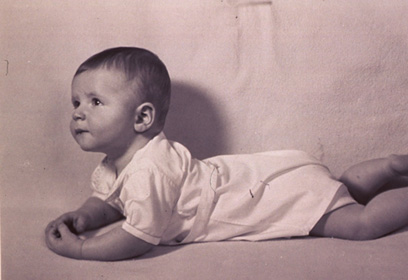Throughout most of the twentieth century, infants slept on their stomachs. But in 1992 the American Academy of Pediatrics began urging parents to put infants to sleep on their backs. The goal was to reduce the incidence of sudden infant death syndrome (SIDS), the unexplained demise of an apparently healthy sleeping baby and, in the United States, the leading cause of death among infants between one month and one year of age. Soon the National Institutes of Health joined in with its own effort. And it worked: parents began to ensure that their infants no longer lay prone in their cribs.
Then something unexpected happened. By 1998 doctors noticed that infants who slept on their backs or sides reached certain motor development milestones more slowly than did belly sleepers. Many psychologists thought the timing of motor development was innate and a good indicator of the progress of neurological development, so the fact that back-sleepers were slower to roll over, sit supported, creep, crawl, and stand up led to a certain amount of consternation. Some doctors reassured parents that the slower development was still normal, while others wondered whether the call for supine sleeping was overdone and so encouraged supervised prone playtime.
Really though, there is no problem here. Just a worn out theory of development predicated on the similarly depleted nature-versus-nurture debate. As early as 1900, scientists carefully watched infants as they learned to walk. Those first studies recorded many different movements—crawling, creeping, scooting, rolling, bum shuffling—that infants employed to get from one place to another. By the 1930s observers of child development had become fascinated with defining the normal. Psychologist Arnold Gesell pioneered this movement when, in the late 1920s, he filmed and categorized the growth patterns of fifty-one children of Northern European extraction living in New Haven, Connecticut. (Nowadays some researchers call such a sample WEIRD—Western Educated Industrial Rich Democratic.) From this group he produced an extensive set of normal developmental stages and timetables, updated versions of which continue to adorn the walls of many a pediatrician’s office.
Gesell thought that each new skill appeared as an infant’s brain and muscles matured via intrinsic biological processes, that his timetables were universally true and thus a good way to decide if a baby was developing normally. While he acknowledged that infants needed training to learn to walk, he thought the underlying driver was nature—the supposedly innate maturation process of the cerebral cortex.
Imagine the astonishment, then, of Western anthropologists when they discovered that infants in several African and Caribbean communities reached benchmarks of sitting, standing, and walking weeks or even months before the Gesell norms. Babies could walk at nine to ten months and run at a year. So-called African precocity challenged the idea of a universal, predetermined pattern for human development.
The challenge was double-edged. On the one hand, the “precocity” might suggest a biological difference among the races. Perhaps different races followed different patterns of development. The trouble with Gesell’s theory, on this view, is not its reliance on orderly, predictable stages but its false universality. On the other hand, maybe the idea that there are fixed standard patterns is itself wrong, in which case the issue is not that European and African babies differ by nature but that development itself is a flexible process in which nurture actually changes nature, just as nature may shape nurture.
Over the last fifty years, anthropologists have shown convincingly that variation in infant development is a product not of racial difference but of the lack of a fixed developmental pattern. Specific child rearing practices affect the timing of infant motor development. In locales where children walk sooner than the Gesell standard, caregivers massage and exercise infants with a daily routine consciously aimed at encouraging walking. These infants rarely lie down. Instead they nap in slings carried by their mothers and thereby experience more shaking, rocking, and gravity resistance than your average crib-napping kid. Studies have shown that the more massaging, shaking, stretching, and jostling a child experiences, the earlier he or she starts to walk.
It is easy, but wrong, to see development in terms of ‘genes for X’ or a nature/nurture balance.
Which brings us back to the American infants who sleep on their backs. Belly sleepers have more opportunity to exercise their arms and trunk by pushing up from a prone position. So the creeping and crawling skills that require upper body strength and coordination develop sooner in belly than in back sleepers.
Today’s motor development researchers no longer believe in the Gesell model. They see neither a definitive starting nor ending point (other than death) for learning motor skills. Even in the womb, the fetus stimulates nerve-muscle-brain development and coordination by wiggling and kicking. As the fetus grows, the available kicking room lessens and the types of leg movements change. Here, in a liquid medium that counteracts the pull of gravity, the walls of the amnion constrain and guide movement. After birth, there is no fixed, gene-generated program of brain development that sets a timetable for motor stages that lead to walking. Instead the developmental process involves continual feedback between infant and environment. And by environment, I mean everything from gravity and diet to restrictive clothing (or going naked) to the stimulatory practices of a baby’s caregivers, to prone versus supine sleeping.
Most people have only one model to think about how human traits develop. Whether they call themselves determinists or constructionists, nativists or empiricists; whether they emphasize genes or environment, nature or nurture, or think of important traits as hardwired or plastic, they envision a seesaw. Sometimes nature (genes, wiring, etc.) is heavier, and the seesaw bounces onto nature’s ground. Sometimes the environment (culture, nurture) is heavier and weighs down that end of the seesaw. Frustratingly, even though a process approach to understanding motor development is pretty much settled science, in most other arenas (sex differences, intelligence, athletic and musical ability, and more), people can’t stop arguing—adding a little weight to one side or there to the other—and the seesaw teeters back and forth with each new research finding.
But there is no seesaw. Human behaviors are not “things” more or less influenced by one or another source. They are processes that are simultaneously embodied and shaped by experience. The behavior of walking, as just one example, differs from one individual to the next depending on health history, body size and shape (for example, limb-to-trunk length ratios), past physical experience, the character of the walking surface, clothing, and many other factors.
Walking is softly assembled from all of these systems. For most of our lives—barring illness and accident—this softly assembled state is pretty stable. But it changes in minor ways as we grow from child to adult, as our knees become arthritic, or we start to wear “sensible shoes.” Stability, though, can descend into chaos due to serious accident or disease. Sometimes, as when amputees learn to walk again with an artificial limb, a new stability emerges. As months of rehabilitation forge new and different neural pathways connecting the muscles and the brain and spinal cord to the attachment site of the leg, the limb incorporates into the body.
Walking is always a dynamic process, not a fixed trait. It is profoundly constructed; and it is profoundly natural. The same can be said of most, if not all, human behavior. But this is difficult to accept. It is easy to visualize human development in terms of “genes for X” or a balancing seesaw. Complex systems in relatively stable harmony, but occasionally drifting into chaos only to re-stabilize with new connections—that is harder to grasp. So while specific nature-versus-nurture debates, such as that over walking, may dissolve, the notion of the seesaw, of genes for certain behaviors, remains seductive in both public and scientific discourse.








